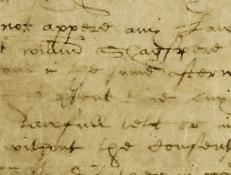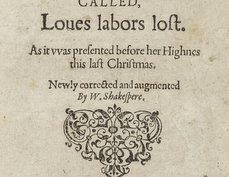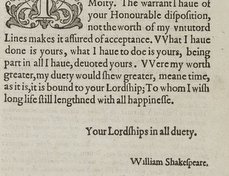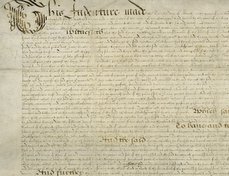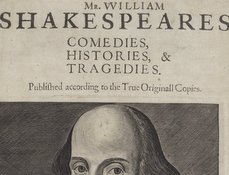Terms of use
The Bishop of Worcester has graciously contributed the above image from his collections to Shakespeare Documented, and retains sole ownership of said image. Visitors may link to and cite the image within Shakespeare Documented in personal research only. Any further use, including, but not limited to, unauthorized downloading or distribution of the image is strictly prohibited. Visitors must request permission from the Bishop of Worcester (care of The Registrar of the Diocese of Worcester, 8 Sansome Walk, Worcester, WR1 1LW, United Kingdom) for any additional use.
Document-specific information
Title: Entry in the Bishop's register
Date: November 1582
Repository: The Diocese of Worcester, Worcester, UK
Call number and opening: b716.093 BA 2648/10 (i), fol. 43v-44r
Robert Bearman, "Entry in the Bishop's register concerning the marriage of William Shakespeare and Anne Hathaway," Shakespeare Documented, https://doi.org/10.37078/678.
Diocese of Worcester, b716.093 BA 2648/10 (i). See Shakespeare Documented, https://doi.org/10.37078/678.
Two documents record the marriage of William Shakespeare and Anne Hathaway but the evidence is flawed. An entry, dated November 27, 1582, in the bishop of Worcester’s register, shown here, records that a license was granted to William Shakespeare for his marriage to Anne Whateley of Temple Grafton. However, the other is a bond dated the next day that there was nothing to prevent the marriage taking place between William Shakespeare and Anne Hathaway of Stratford-upon-Avon, and that the bishop would be
safeguarded from any future possible objections.
William Shakespeare married Anne Hathaway late in November 1582. However, the marriage did not take place in the couple’s parish church at Stratford-upon-Avon and nor were the banns read there three times, as would normally have been required. Instead application was made to the bishop of Worcester, in whose diocese Stratford then lay, for a license for the marriage to take place elsewhere after a single reading of banns. The license itself, which would have been addressed to the minister of the church at which the ceremony was to take place, is not extant. However, no existing surviving parish register records the event; therefore Shakespeare’s marriage may have taken place at any local church without a surviving register.
Anne Hathaway was three months pregnant (the couple’s child was born the following May) and the couple’s relative ages were unusual. William was eighteen, one of only three known teenage bridegrooms marrying in Stratford during the years 1570 to 1640. This was well below twenty-six, the average age during that period. At the age of twenty-six, most young men from Shakespeare’s background would have completed their apprenticeship and acquired an establishment in which to raise a family independently. At twenty-six, Anne Hathaway was eight years older than Shakespeare. This in itself was unusual, but it also put her two years beyond the average age of women at their first marriage, twenty-four. These considerations do not rule out a marriage for love, but have cast suspicion on whether the couple would have married if Anne had not been pregnant.
Considering Anne’s pregnancy, scholars have argued that the couple may have been married by license because there was insufficient time for the reading of banns three times before Advent began on December 2. Advent, the church season before Christmas, was a customary prohibited period for marriages, which lasted until eight days after Epiphany, observed twelve days after Christmas. However, this does not explain why the couple married outside their parish church.
The entry that on November 27, 1582 a license had been issued for the marriage of William Shakespeare and Anne Whateley of Temple Grafton occurs on folio 43v of a register in use since the appointment of Nicholas Bullingham as bishop in 1571. Initially this had been divided into two sections, the first (from folio 1) recording most routine diocesan business, with the second (beginning on folio 44) listing ordinations only. At first, the issuing of licenses, mainly for marriages but occasionally for other purposes, formed only a small part of routine business, and are found interspersed with other routine business in the first section. However, by 1579 the issuing of licenses had become sufficiently common to warrant its separate listing. This list of licenses begins on folio 34 and subsequent entries, up to the middle of December 1582, fill folios 34-43v. As the ordination section, begun in 1570, occupied folio 44 and several further leaves, the list of licenses was continued on folio 51 with entries added until the end of 1585 up to folio 58.
There must be a reason for the discrepancy in the bride’s description – Anne Whateley of Temple Grafton in the register and Anne Hathaway of Stratford-upon-Avon in the bond. The bond is an original document, and is more likely to be correct. The discrepancy might therefore simply be explained as a clerical error made by the man entering the note in the register shown here. Although this may seem unlikely at first, we need to be clear about when the entry was actually made. The list of licenses covering the years 1579 to 1584, now occupying folios 34-43v, folios 51-58, is in the same neat hand, and certainly does not have the appearance of being made up day-by-day, or even week-by-week. In other words, the clerk must have been writing up the entries (at least in blocks) from either notes made at the time the licenses were issued, or from one of the series of original documents which would have been produced in the process of securing a license. In any event, this process of retrospective copying, or even re-copying, could have well led to errors. In fact, comparison of other register entries with surviving bonds does reveal several other discrepancies.
The key entry, on folio 43v, reads: “Item eodem die similis emanauit licencia inter Willelmum Shaxpere et Annam Whateley de Temple grafton.” (Also on the same day a similar licence was issued between William Shakespeare of Stratford and Anne Whateley of Temple Grafton). The words “On the same day” refers back to the previous entry for a licence issued on November 27 and “similar” to the fact that all licences since November 17 had been for marriages. If the clerk was indeed in error, a careless misreading of Hathaway for Whateley is certainly a possibility.
Further, there is no other evidence for an Anne Whateley of Temple Grafton. The inclusion of the place name Temple Grafton, however, cannot be so easily explained, though it is possible that the marriage might have taken place there. This would have been specified in the lost licence and then perhaps carelessly assumed to have been the bride’s parish when the entry was copied. It would certainly have been within easy reach of Shottery, the bride’s place of residence. However, the loss of the Temple Grafton parish registers would make purely speculative any firmer proposal that the marriage took place there.
Written by Robert Bearman
Last updated July 14, 2020


